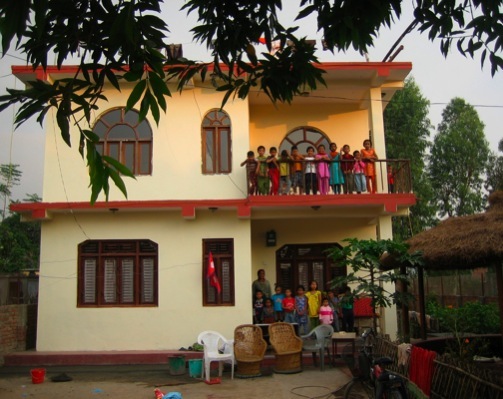
It was never her plan to meet orphans 8,000 miles away, buy a piece of land, build an orphanage on it, then make it and Nepal - a post-civil war country in Southeast Asia - her home for three years.
All she knew was that a gap year program after high school to conduct service learning projects in a foreign country would, at the very least, enrich her life.
But, while visiting an orphanage on her trip to Northeast India, Maggie met 16-year-old Sunita.
Her story was not uncommon as Nepal underwent a massive civil war between 1996 and 2006. During the conflict, more than 13,000 people were killed and thousands displaced.
Sunita had left her war-torn country of Nepal 7 years before
and had never gone back. So, she and Maggie set off on a 4-day trek through the
Himalayan Mountains to locate Sunita's family.
"It was this huge eye opener. Her village had been converted into a military base and I was the first foreign person ever to visit this village," said Maggie, a fresh-faced, White girl from New Jersey.
After travelling around Nepal for two weeks, Maggie settled in Surkhet. It was a small district in the Mid-Western Development Region of Nepal that boasted various signs of civilization like a post office, a hospital, schools and a bank, yet was home to children who were considered the society's dross.
"While there, I met all these child laborers who had no one in the world to care for them," said Maggie. "To me, it was an urgent situation."

"Before we knew it, we had about 250 people that were ready to work. So, I called home and asked my parents to wire me the babysitting money I had saved up so I could buy a piece of land and build on it," said Maggie.
It was only $5,000, but it was more than enough.
This $5,000 gave three-year-old Shanti who had walked through desert for 26 days and passed over 40 worms from her body a place of solace.
This $5,000 gave 10-year-old Rupa who was bein
This $5,000 gave a total of 26 children - ages three to 10 - a safe space filled with love, nutritious food, clean water, medical care, clothing and soft beds called the Kopila Valley Children's Home.
And now, Maggie has even more to work with. This month, she was awarded the ultimate grant for her project: $100,000 from Do Something, a non-profit organization that gives young activists the tools to sustain their projects of social change.
"It feels like I won $10 million because it's really going to a long way," said Maggie.
Maggie travelled from Nepal to New York for the awards ceremony on June 4.
And, after a month's worth of well-deserved respite at her home in New Jersey, she will head back to Nepal to put the grant to use. She and her team will set out to build a school.
Providing the children with a multidimensional educational experience that both embodies and reaches beyond the traditional classroom is the ultimate objective.
This learning model will include art, music, world religion,
sustainability, project-based learning and most radically, "a
"You hit a kid once and you're out," said Maggie. "What we're dealing with here is a 100-year-old system of education. It's rote memorization, kids are slapped and beaten with sticks... We want to create a school that can be used as a model for others schools in Nepal."
The school will service orphans, street kids, child laborers, ex-conscripted child soldiers and abused children in the region.
And, as part of the school, there will be an in-house medical clinic, a women's literacy group, and tutoring for grades K-8.
"These kids are not too far gone," said Maggie. "They can have childhoods again, they can laugh again. They just need the very basic things."
For more information about Maggie and the Kopila Valley Children's home, visit www.blinknow.org


